A prefecture is an administrative jurisdiction traditionally governed by an appointed prefect. This can be a regional or local government subdivision in various countries, or a subdivision in certain international church structures, as well as in antiquity a Roman district
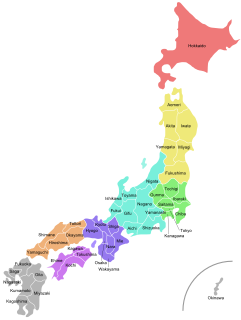
Japan is divided into 47 prefectures, forming the country's first level of jurisdiction and administrative division. They include 43 prefectures proper, two urban prefectures, one "circuit" or "territory" and one "metropolis". In 1868, the Meiji Fuhanken sanchisei administration created the first prefectures to replace the urban and rural administrators in the parts of the country previously controlled directly by the shogunate and a few territories of rebels/shogunate loyalists who had not submitted to the new government such as Aizu/Wakamatsu. In 1871, all remaining feudal domains (han) were also transformed into prefectures, so that prefectures subdivided the whole country. In several waves of territorial consolidation, today's 47 prefectures were formed by the turn of the century. In many instances, these are contiguous with the ancient ritsuryō provinces of Japan.
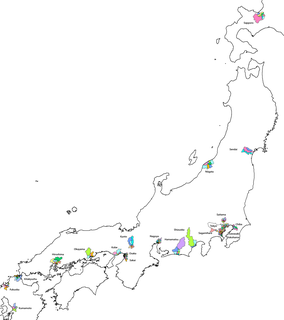
A ward is a subdivision of the cities of Japan that are large enough to have been designated by government ordinance. Wards are used to subdivide each city designated by government ordinance. The 23 special wards of Tokyo Metropolis have a municipal status, and are not the same as other entities referred to as ku, although their predecessors were.
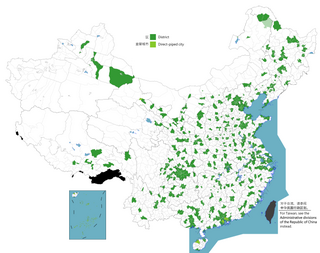
The term district, in the context of China, is used to refer to several unrelated political divisions in both ancient and modern China.
South Korea is made up of 17 first-tier administrative divisions: 6 metropolitan cities, 1 special city, 1 special self-governing city, and 9 provinces, including one special self-governing province. These are further subdivided into a variety of smaller entities, including cities, counties, districts, towns, townships, neighborhoods and villages.

The Gangnam District, also romanized as Kangnam, is one of the 25 local government districts which make up the city of Seoul, South Korea. Gangnam literally means "South of the (Han) River". Gangnam District is the third largest district in Seoul, with an area of 39.5 km2 (15.3 sq mi). As of the 2017 census, Gangnam District had a population of 561,052. There is a high concentration of wealth in the district with prices for an apartment as of 2020 having risen by 83 times in 40 years compared to just 6 times in the rest of Seoul.

Seocho District (Korean: 서초구) is one of the 25 gu which make up the city of Seoul, South Korea. Seocho is generally referred to as a part of Greater Gangnam Area, along with Gangnam District and Songpa District. As of 2019, Seocho District ranks as the second richest neighborhood in South Korea and among the most expensive areas in Seoul with an average sales price of 47.75 million South Korean won per 3.3 square meters. South Korea's rich are concentrated in the three Gangnam districts including Seocho, known as Gangnam-sam-gu.

Dong District is a gu in central Busan, South Korea. It was one of the first 6 gu of Busan established in 1957.
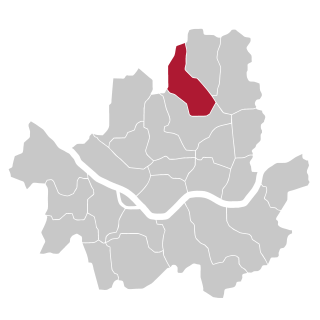
Gangbuk District (Gangbuk-gu) is one of the 25 gu which make up the city of Seoul, South Korea. Its name is derived from the fact that it is located at the north of Han river. It was created from neighbouring Dobong District (도봉구) in 1995. The current mayor is Park Gyeom-su(박겸수).

Eunpyeong District is one of the 25 districts of Seoul, South Korea.

Seongdong District (Seongdong-gu) is one of the 25 gu which make up the city of Seoul, South Korea. It is situated on the north bank of the Han River. It is divided into 20 dong (neighbourhoods).

Jongno District is a district in central Seoul, South Korea. It takes its name from a major local street, Jongno, which means "Bell Street".

Dongjak District (Dongjak-gu) is one of the 25 gu that make up the city of Seoul, South Korea. Its name was derived from the Dongjaegi Naruteo Ferry, on the Han River which borders the district to the north. It was the 17th gu created in Seoul, after being separated from Gwanak District on April 1, 1980.
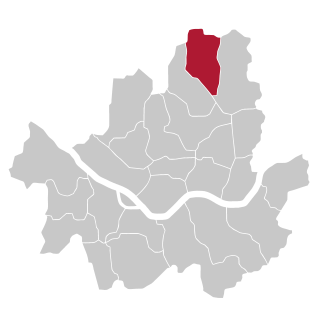
Dobong District is one of the 25 districts of Seoul, South Korea.

Dongdaemun District is one of the 25 districts of Seoul, South Korea.

Jangan-gu, established on July 1, 1988, is the northern district of the city of Suwon in Gyeonggi-do, South Korea. It's approximately 15 km. from central Seoul.

Bupyeong District (Bupyeong-gu) is one of the 10 administrative divisions that comprise Incheon, South Korea. Bupyeong-gu comprises an area of 12.35 square miles, and has a population of 508,587. It is located north of Namdong-gu, east of Seo-gu, and south of Gyeyang-gu. The city of Bucheon, in neighboring Gyeonggi Province, comprises its eastern limit.

The Seoul Metropolitan Government is a local government of Seoul, South Korea. The mayor is elected to a four-year term by the citizens of Seoul and is responsible for the administration of the city government. The Seoul Metropolitan Government deals with administrative affairs as the capital city of South Korea. Hence, it is more centralized than that of most other cities, with the city government being responsible for correctional institutions, public education, libraries, public safety, recreational facilities, sanitation, water supply, and welfare services.















